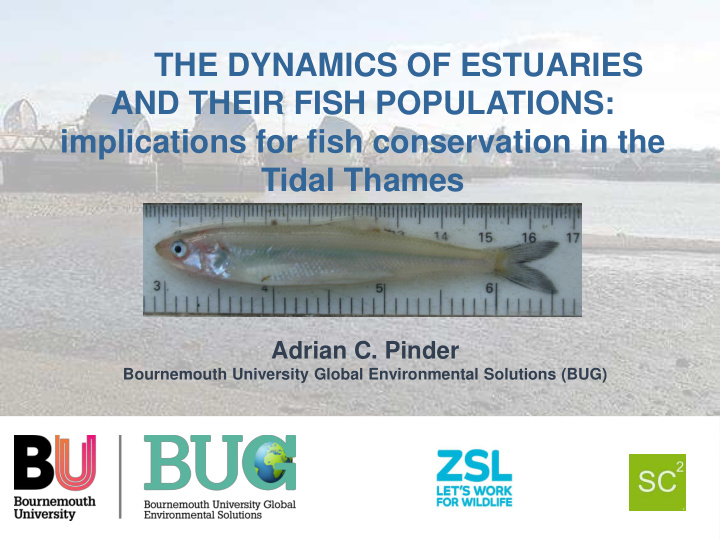



THE DYNAMICS OF ESTUARIES AND THEIR FISH POPULATIONS: implications for fish conservation in the Tidal Thames Adrian C. Pinder Bournemouth University Global Environmental Solutions (BUG)
ESTUARIES AND THEIR VALUE: wildlife
ESTUARIES AND THEIR VALUE: leisure
ESTUARIES AND THEIR VALUE: commercial fisheries
ESTUARIES AND THEIR VALUE: development & transport
ESTUARIES AND THEIR VALUE: power generation
Threats to fish populations • Pollution (industrial, domestic, agriculture) • Habitat loss • Noise • Entrainment / impingement
WHY DO FISH USE ESTUARIES?: Diadromy Elliott et al. (2007). The guild approach to categorizing estuarine fish assemblages: a global review. Fish and Fisheries , 8 (3), 241-268.
WHY DO FISH USE ESTUARIES?: Nursery function • Globally recognised as important nursery zones • Freshwater and marine species • Rich feeding opportunities / Predator avoidance prospects
THE CONCEPT OF ONTOGENETIC ECOLOGY
MORPHOLOGICAL AND PHYSICAL CHANGE IN FISHES • Fish transition through a number of well defined ontogenetic stages • Thresholds between stages often translate to sudden shifts in behaviour and ecology
CHANGING HABITAT AND ITS VALUE TO 0+ FISHES boulders sand bar mud flats shingle
Factors influencing estuarine utilisation of 0+ fishes Freshwater Marine Estuary Flow rate Abiotic Salinity & turbidity Tidal cycle Highly mobile and temporally dynamic Production of Production of Production of Biotic freshwater estuarine & Marine fish communities & anadromous fauna anadromous fauna & catadromous fauna Temporal Seasonal Seasonal Seasonal bio-rythms bio-rythms bio-rythms
Current research on the Tidal Thames 0+ FISH IN THE THAMES Investigating the ecological function of the Tidal Thames and the impact of improved water quality on fish populations 125 species since Tidal Thames Biological Timeline 1964; nursery for 21 species 1800 2000 1850 1900 1950
PROJECT OBJECTIVES • Characterise temporal variability in fish species community structure and abundance • Construct pre-Tideway improvement ecological baseline • 3D utilisation of space and tides?
GLASS EEL MIGRATION MODEL • Developed to help quantify recruitment and exploitation of glass eels ascending the Bristol Channel rivers Harrison, A. J. et al. (2014). A review of glass eel migratory behaviour, sampling techniques and abundance estimates in estuaries: implications for assessing recruitment, local production and exploitation. Reviews in fish biology and fisheries , 24 (4), 967-983.
PROJECT OBJECTIVES • Characterise temporal variability in fish species community structure and abundance • Construct pre-Tideway improvement ecological baseline • 3D utilisation of space and tides? • Communicate the importance of the tidal Thames to the general public through citizen science involvement
Current monitoring – Temporal and spatial survey effort • Two year programme (2017-2018) • Fortnightly (March – November) Blackfriars Putney Greenwich
Current monitoring – survey methods • Bespoke multi-method approach • Seine netting (3mm mesh) at low tide (general fish community structure at each site)
Current monitoring – survey methods • Marginal push nets (1.5mm mesh) used two hours either side of low tide (importance of extreme margins for refuge and STST)
Current monitoring – survey methods Mid-channel ichthyoplankton trawls during flood and first hour of ebb tides (to determine utilisation of main channel for surface eggs/larval transport (STST) 2m
Current monitoring – initial observations Freshwater Diadromous Marine Roach Rutilus rutilus European eel Anguilla Sea bass Dicentrarchus anguilla labrax Dace Leuciscus leuciscus Smelt Osmerus eperlanus Thinlip mullet Chelon ramada Perch Perca fluviatilis Sand smelt Atherina presbyter Bullhead Cottus gobio Common goby Pomatoschistus microps 3- sp’ stickleback Gasterosterus Sand goby Pomatoschistus aculeatus minutus 9- sp’ stickleback Pungitius Flounder Platichthys flesus pungitius Common bream Abramis Snake pipefish Entelurus brama aequoreus Ruffe Gymnocephalus cernua Zander Sander lucioperca 20 species so far…. Chub Squalius cephalus Bleak Alburnus alburnus
Current monitoring – ontogenetic shifts Flounder Platichthys flesus
MANAGEMENT IMPLICATIONS Theoretical approach Evidence based management strategy
Thank you – any questions?
Recommend
More recommend